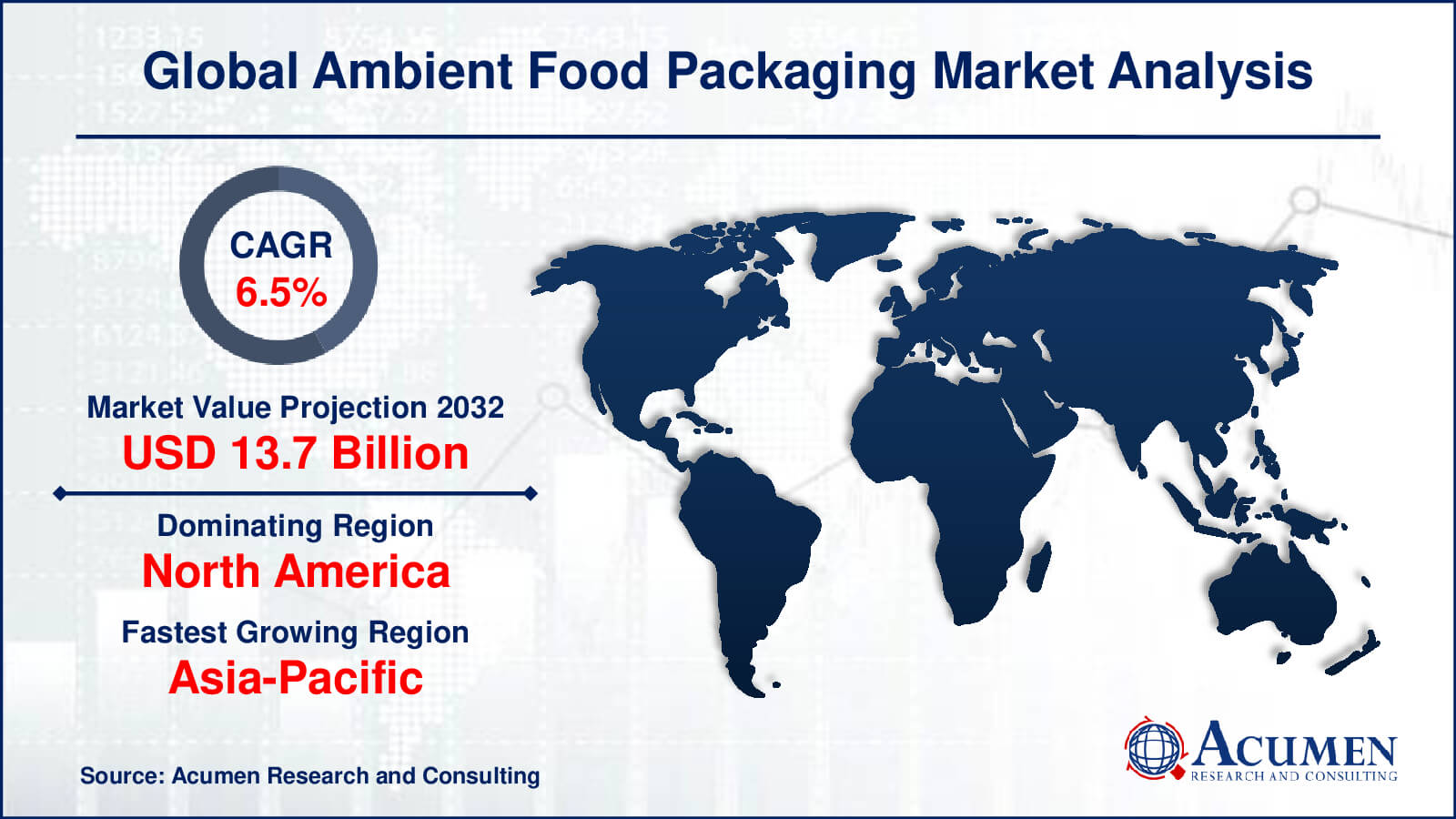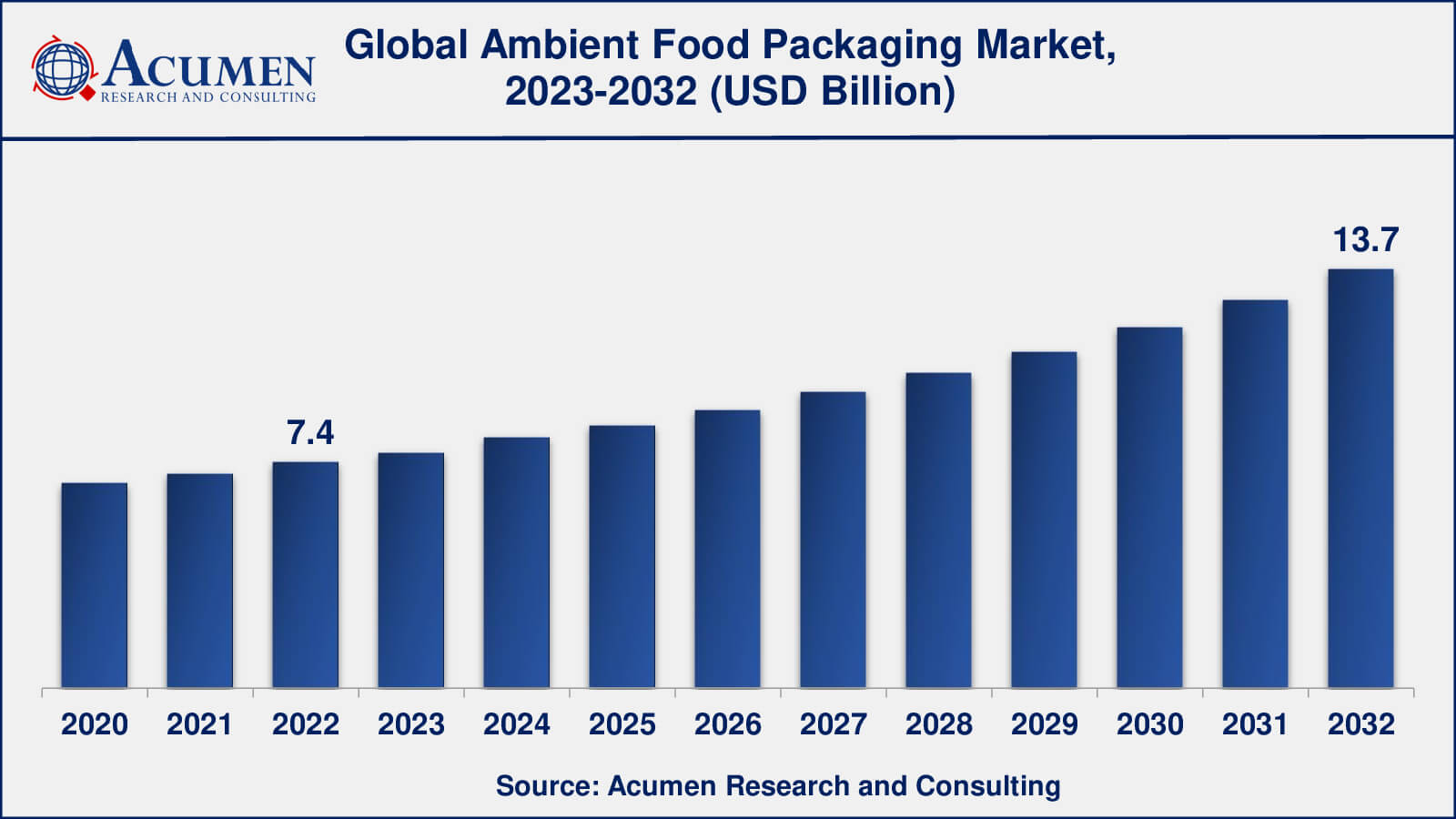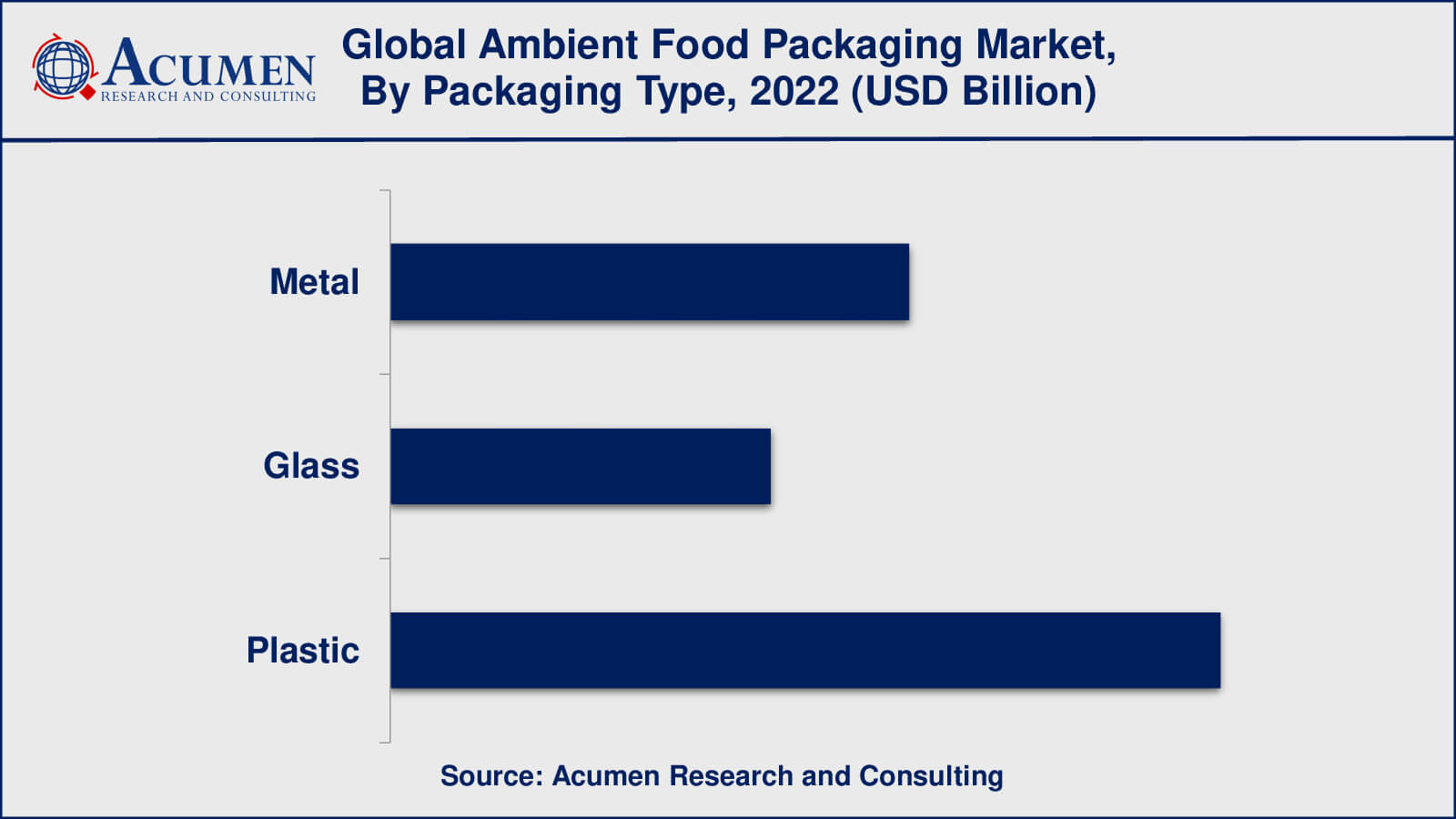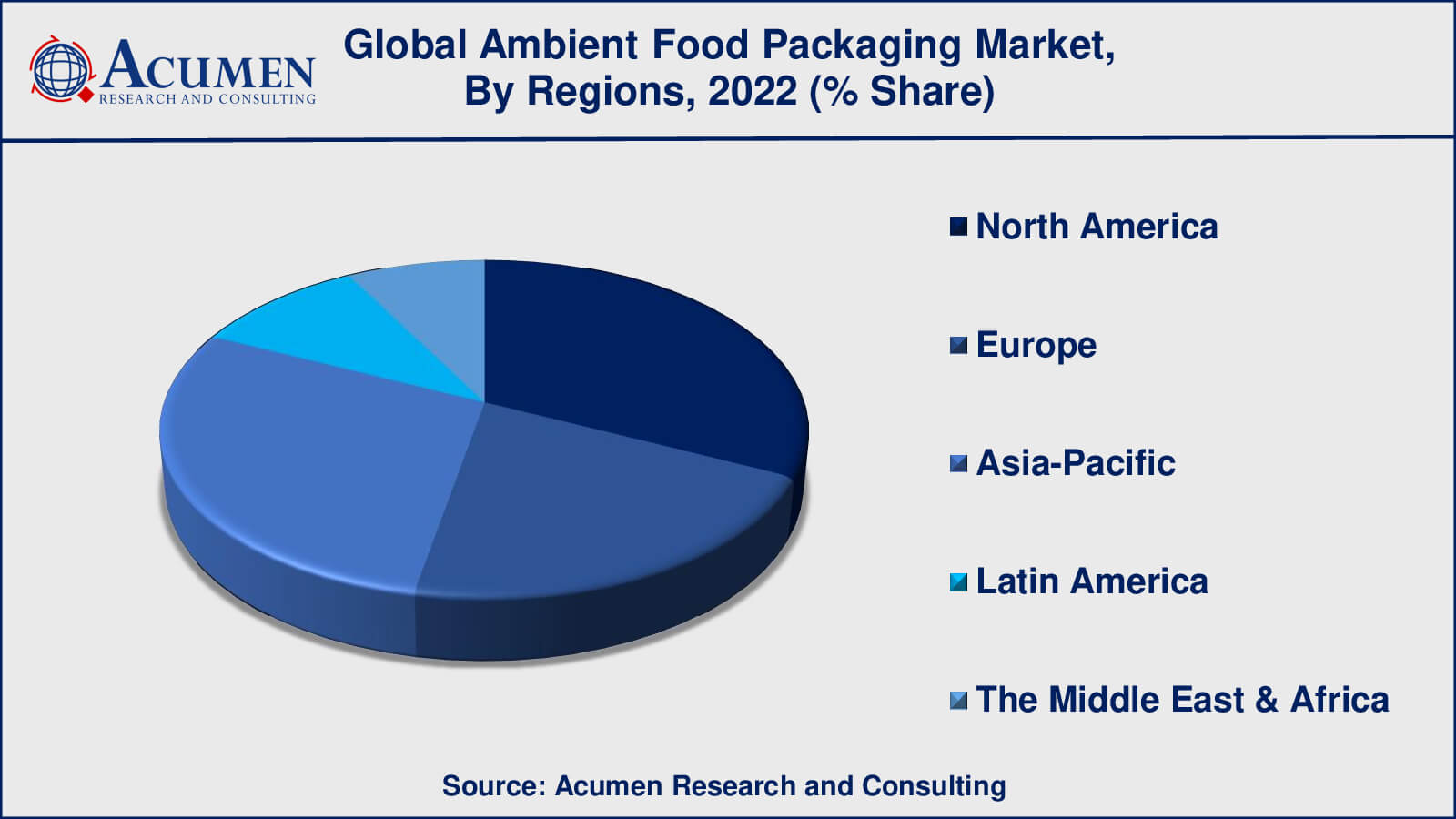March 2023
Ambient Food Packaging Market Size collected USD 7.4 Billion in 2022 and is set to achieve a market size of USD 13.7 Billion in 2032 growing at a CAGR of 6.5% from 2023 to 2032.
The Global Ambient Food Packaging Market Size collected USD 7.4 Billion in 2022 and is set to achieve a market size of USD 13.7 Billion in 2032 growing at a CAGR of 6.5% from 2023 to 2032.
Ambient Food Packaging Market Report Statistics

Foods that are retailed and stored at normal room temperature are called ambient food. This type of food has a longer shelf-life and fights harmful microorganisms with advanced heat treatment. Shelf life is the time span of food for which it can be kept under required conditions keeping in mind optimum quality and safety. It begins with manufacturing and depends on packaging type, ingredients, storage conditions, and manufacturing process among others. Generally, the shelf life of a food product is determined during the manufacturing process. Manufacturers determine the extrinsic and intrinsic of the food products that affect their quality and safety. These include manufacturing process, ingredients used, packaging type, and storage conditions among others. Two major processes for ambient food packaging are sterilization and pasteurization. Increasing competition for chill cabinet space signifies the increasing demand for food packaging that provides longer shelf life. The increasing trend towards sustainable packaging products is significant in the case of ambient food packaging. Different food packaging and preservation processes are used to increase product shelf life. Increasing the product’s acidity, decreasing its water content, and using airtight envelope can increase the product’s shelf life without changing its texture and taste.

Global Ambient Food Packaging Market Dynamics
Market Drivers
Market Restraints
Market Opportunities
Ambient Food Packaging Market Report Coverage
| Market | Ambient Food Packaging Market |
| Ambient Food Packaging Market Size 2022 | USD 7.4 Billion |
| Ambient Food Packaging Market Forecast 2032 | USD 13.7 Billion |
| Ambient Food Packaging Market CAGR During 2023 - 2032 | 6.5% |
| Ambient Food Packaging Market Analysis Period | 2020 - 2032 |
| Ambient Food Packaging Market Base Year | 2022 |
| Ambient Food Packaging Market Forecast Data | 2023 - 2032 |
| Segments Covered | By Packaging Type, By Material Type, By Application, And By Geography |
| Regional Scope | North America, Europe, Asia Pacific, Latin America, and Middle East & Africa |
| Key Companies Profiled | RPC Group, Amcor Limited, FFP Packaging Solutions Ltd., Tetra Pak, Rexam, Mondi, SIG Combibloc Group AG, DuPont, Ampac, Marsden and KM Packaging. |
| Report Coverage |
Market Trends, Drivers, Restraints, Competitive Analysis, Player Profiling, Covid-19 Analysis, Regulation Analysis |
Ambient Food Packaging Market Growth Factors
Ambient packaging offers extended food shelf life compared to other types of packaging which enables storing at room temperature. Increasing demand for food safety, attractive packaging style, and consumer convenience among others are some of the major factors driving the growth of the ambient food packaging market, globally.
Food items such as bakery and confectionery products, daily meal items, dairy products, and packaged meat among others get contaminated if they are not consumed within a month from packaging. This creates financial losses for retailers. To overcome the issue, food packaging manufacturers developed an ambient packaging concept that maintains product quality and extends the product's shelf life. There is a shifting trend towards ambient food packaging among consumers as ambient food packaging offers enhanced food quality (in terms of freshness, flavor, and color).
The ambient packaging manufacturers are continuously involved in new packaging processes that extend product shelf life and prevent contamination. Food packaging can be done in cans, cups, sachets, tubes, and bottles according to customer convenience and product requirements. Ambient food packaging manufacturers have also started offering services such as injection molding, thermoforming, and blow molding which are also fueling the demand for ambient packaging. High cost in the case of ambient packaging is a restraint for the growth of the overall market.
Ambient Food Packaging Market Segmentation
The worldwide ambient food packaging market is categorized based on packaging type, material type, application, and geography.
Ambient Food Packaging Market By Packaging Type

According to the ambient food packaging market forecast, flexible packaging sub-segment is expected to lead the market from 2023 to 2032. Flexible packaging is widely used in the ambient food packaging market due to its versatility, cost-effectiveness, and capability to safeguard food products from external factors such as light, air, and moisture. Pouches, bags, films, and wraps are examples of flexible packaging used to package a variety of ambient food products such as snacks, bakery, confectionery, and beverages. The growing consumer preference for sustainable packaging solutions, as well as advancements in packaging technology that enable improved protection and longer shelf life of food products, are driving demand for flexible packaging in the ambient food packaging market.
Ambient Food Packaging Market By Material Type
Plastic is currently the most widely used material in the ambient packaging market. Plastic made up the majority of the ambient food packaging market in 2022, according to our ambient food packaging industry analysis, due to its versatility, cost-effectiveness, and capacity to secure food products from external factors such as light, air, and moisture. Plastic is widely used in a wide range of ambient food packaging applications, including bags, pouches, films, and wraps, and is preferred by food producers and retailers due to its durability, lightweight, and ability to be customized for branding and marketing.
However, there is a growing demand for environmentally friendly and sustainable packaging solutions, which may have an impact on plastic's dominance in the ambient food packaging market. Glass and metal are two distinct packaging materials that offer benefits in terms of sustainability, recyclability, and safety, and are increasingly being used by food manufacturers and retailers. Nonetheless, due to its versatility, cost-effectiveness, and ability to meet a broad range of packaging needs, plastic is projected to stay a dominant material in the ambient food packaging market in the near term.
Ambient Food Packaging Market By Application
In 2022, the baby food application held the largest share of the ambient food packaging market. This is due to the growing demand for convenient, ready-to-eat baby food products, along with the need for packaging solutions that assures the products' safety and freshness. Ambient food packaging solutions, such as pouches, jars, and trays, are widely used in the baby food industry because they provide convenience, portion control, and easy storage.
Ready meals, meat and seafood, dairy, fruits and vegetables, and other applications are also driving the growth of the ambient food packaging market. Ready meals, in particular, are gaining popularity due to their convenience and time-saving benefits, and they are frequently packaged in ambient packaging solutions such as pouches, trays, and bags. Meat and seafood, dairy, and fruits and vegetables are also important applications in the ambient food packaging market, as there is a growing demand for packaging solutions that provide extended shelf life, freshness, and safety.
Ambient Food Packaging Market Regional Outlook
North America
Europe
Asia-Pacific
Latin America
The Middle East & Africa

Ambient Food Packaging Market Regional Analysis
North America and Europe are mature ambient food packaging markets, with a high level of awareness and introduction of modern packaging technologies and sustainability practices. These regions are distinguished by a strictly regulated food industry with stringent food safety and quality standards. The United States is the largest industry for ambient food packaging in North America, owing to rising demand for convenience foods as well as ready-to-eat meals. Germany, the United Kingdom, and France are key markets for ambient food packaging in Europe, with a focus on sustainability and environmentally-friendly packaging solutions.
The Asia-Pacific market for ambient food packaging is rapidly expanding, owing to factors such as population growth, urbanization, and rising disposable incomes. With a growing interest in processed foods and ready-to-eat meals, China is a major market for ambient food packaging. Other key markets in the area include India, Japan, South Korea, and Southeast Asia, where innovative and cost-effective packaging solutions are in high demand.
Ambient Food Packaging Market Players
Some of the global ambient food packaging companies profiled in the report include RPC Group, Amcor Limited, FFP Packaging Solutions Ltd., Tetra Pak, Rexam, Mondi, SIG Combibloc Group AG, DuPont, Ampac, Marsden and KM Packaging.
Looking for discounts, bulk pricing, or custom solutions? Contact us today at sales@acumenresearchandconsulting.com
March 2023
October 2020
March 2020
July 2021